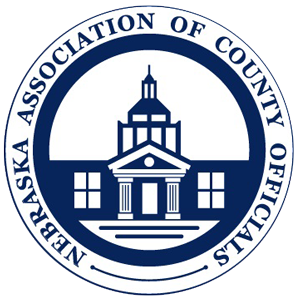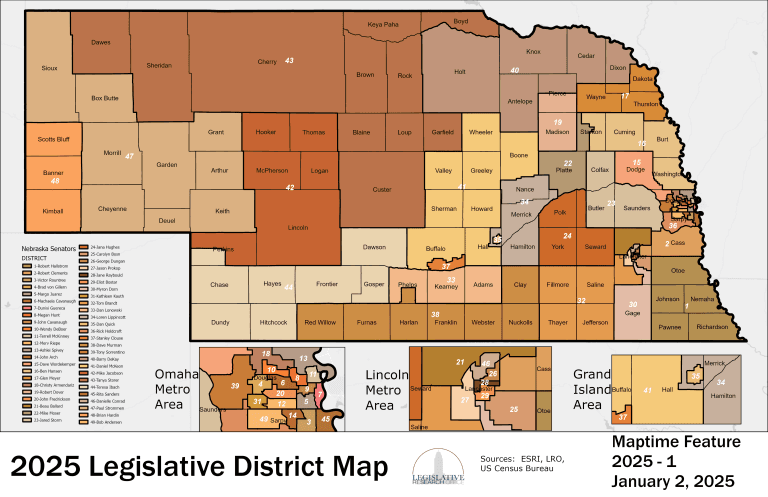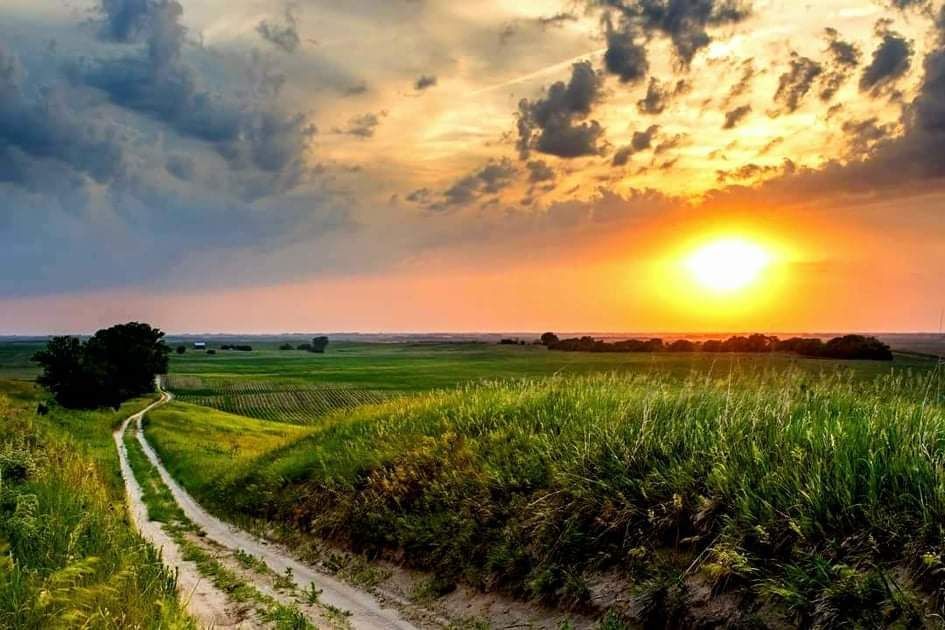- General Info
- Demographics
- Education and Employment
- Valuation and Taxes Levied
- State Senators
- History
- County Programs
- Other Information
Communities and Development
Loup County Seat: Taylor
Total County Population: 607
- Villages (pop.): Taylor (141)
- Unincorporated Pop. (% of county pop.): 466 (77%) 2020
Land Development (% of total land in county):
- Agriculture: 95%
- By method: Pasture (pure grassland) (89%); Irrigated (row crop/grain/forage) (4%); Dryland (row crop/grain/forage) (2%) • Neb. Dept. of Rev. - total equals agriculture's %
- By commodity: Livestock (grassland) 90%, Corn 2%, Soybeans 1%, Alfalfa 1%, Sorghum 1% • USDA - equals agriculture's % plus some wetlands (2%) and minus public grassland/wetlands and reserve
- Residential, Commercial, Industrial, Conservation Reserve & Exempt (combined): 5% 2022
County Offices
Courthouse Address and Hours:
408 4th Street
Taylor, Nebraska 68879
M-TH 8:30 am - 5:00 pm & 8:30 am - 12:00 pm Friday
County Board Chairperson: David Larson
Complete list of county board members
County Board Meetings: 2nd Wednesday
View the County's Government Maps
NACO District: Central
General
Population: 607
Land area (sq. mi.): 563.52
Population per square mile: 1.1
Race and Age
Race 2020
White: 93.1%
African American: 0.0%
American Indian: 0.0%
Asian: 0.2%
Hispanic: 3.0%
Native Hawaiian and Pacific Islander: 0.0%
Two or More Races: 3.8%
Age 2020
0-17: 18.7%
18-64: 53.3%
65+: 28.0%
Households
Total households: 272 2020
With one child: 30 2022
With 2+ children: 30 2022
With seniors (65+): 100 2022
Socioeconomics
Median household income: $60,156 2023
% of Population in Poverty: 16.4% 2023
# of Housing Units: 419 2020
Owner-occupied rate: 79.0% 2020
Median home price: $130,560 Q4 2024
2024 building permits for detached single family homes: 11
2024 building permits for non-detached housing units: 0 (townhouse, duplex, or apt. unit)
Technology
Access to broadband (100 Mbps via fiber or cable modem): 55.9% 2021
Sources: National Association of Realtors, Nebraska Department of Revenue, Nebraska Legislature, Nebraska Library Commission, U.S. Bureau of Economic Analysis, U.S. Census Bureau (building permits), U.S. Census Bureau (demographics), U.S. Census Bureau (municipalities)
Employment, Schools, and Child Care
Unemployment rate: 4.3% March 2025
County Employment Website: https://nebraskacounties.org/nebraska-counties/county-employment-opportunities.html
High school graduate or higher: 98.2% 2020
School Districts: Loup County Public Schools, Sandhills Public Schools, Sargent Public Schools
Bachelor's degree or higher: 20.6% 2020
Community College Service Area: Mid-Plains Community College
Loup County Economy
Annual Gross Domestic Product (GDP): $48,694,000 2023
Nonfarm Small Business Receipts: $4,736,142 2022
Nonfarm Wage Income: $6,898,000 2022
Farm and Ranch Commodity Sales Receipts: $32,725,000 2022
Farm and Ranch Operations (Non-Sales) Receipts: $3,679,000 2022
- For components of nonfarm small business receipts, nonfarm wage income, and farm & ranch commodity sales and operations receipts, see "Notes" below.
Local Grain Market: Click for today's grain prices in Loup County
Cattle Producers: 67
- Pastureland Cash Rent (avg.): $30/acre 2024
Crop Producers: 46
- Dryland Cash Rent (avg.): $75/acre 2024
- Irrigated Land Cash Rent (avg.): $232/acre 2024
Electricity Providers: Custer PPD
Irrigation and Drinking Water
Rural Irrigation Wells: 137 2024
Rural Livestock Wells: 187 2024
Rural Commercial/Industrial Wells: 2 2024
Rural Drinking Water Wells: 174 2024
Drinking Water Utility Connections: 0 2024
Surface Water Diversions (Irrigation): 51 2024
Click for real time:
Streamflow data on the North Loup River at Taylor
Groundwater level data at western end of Long Valley Rd. (13 mi. northwest of Taylor) • Eastern well in row of 2
Groundwater level data at western end of Long Valley Rd. (13 mi. northwest of Taylor) • Western well in row of 2
Notes
Loup County Economy
- Nonfarm small business receipts are reported by partnerships and sole proprietorships. They do not include receipts reported by cooperative associations.
- Nonfarm wage income is reported based upon the wage earner's residential address; therefore, it also includes wages earned by Loup County residents in other counties or states, but it excludes wages earned in Loup County by residents of other counties or states.
- Nonfarm wage income excludes wages earned by anyone claimed as a dependent.
- Farm and ranch commodity sales receipts and operations receipts are reported based upon the farm or ranch owner's principal county of operations; therefore, those figures also include receipts reported by producers operating principally in Loup County for their production in other counties or states, but the figures exclude receipts reported for production in Loup County by producers operating principally in other counties or states.
Irrigation and Drinking Water
- A rural irrigation well is any well intended for irrigating crops that, either on its own or as part of a set of commingled wells, is capable of pumping more than fifty (50) gallons of water per minute (gpm). Note that some rural commercial/industrial wells are also capable of pumping more than 50 gpm. In Nebraska, the owner of any well--or set of commingled wells--that is capable of pumping more than 50 gpm must register the well(s) with the state government and have a permit for the well(s) from the local natural resource district (NRD).
- Rural livestock wells and rural drinking water (also known as "domestic") wells are not allowed to pump more than 50 gpm unless permitted by the local NRD. Each rural drinking water well usually serves one single family home, though in rare cases a rural drinking water well serves multiple homes.
- Data on rural livestock wells and rural drinking water wells may be incomplete for wells drilled prior to September 9, 1993. State law does not require wells drilled prior to that date to be registered with the state government if the wells are not capable of pumping more than 50 gpm. Neb. Rev. Stat. § 46-735; see Laws 1993, LB 131, § 25.
Sources: National Agricultural Statistics Service (USDA), Nebraska Cooperative Council, Nebraska Coordinating Commission for Postsecondary Education, Nebraska Department of Health and Human Services, Nebraska Department of Revenue, Nebraska Department of Transportation, Nebraska Office of the CIO, Nebraska Power Review Board, Nebraska Public Service Commission, U.S. Bureau of Economic Analysis, U.S. Bureau of Labor Statistics, U.S. Census Bureau, U.S. Energy Information Administration, U.S. Department of the Treasury (IRS), Warehouse and Commodity Management Division (USDA)
2024 Levies and Valuation
County levy rate: $0.2039 per $100 of taxable valuation
County property taxes levied: $771,135
Total local government property taxes levied: $3,562,632
Total countywide taxable valuation: $378,191,445
Federal PILT payment to Loup County (FY2024): $31,423 regarding 9,386 federally-owned acres
Click here for all levy rates in Loup County
County Levy and Taxation Laws
Levy limits
Since 1996, counties and other political subdivisions have been subject to the levy limits listed in Neb. Rev. Stat. § 77-3442 and Neb. Rev. Stat. § 77-3443.
Statutes and regulations
Nebraska Revised Statutes (Chapter 77)
Nebraska Administrative Code (Title 350)
Local tax reductions, exemptions, and credits
Neb. Rev. Stat. § 76-902(5)(a) (Deed "stamp tax" exemption): "The [stamp tax] shall not apply to: ... (5)(a) Deeds between spouses, between ex-spouses for the purpose of conveying any rights to property acquired or held during the marriage, or between parent and child, without actual consideration therefor."
Neb. Rev. Stat. § 77-201(2) (Valuation of agricultural land and horticultural land): "Agricultural land and horticultural land as defined in section 77-1359 shall constitute a separate and distinct class of property for purposes of property taxation, shall be subject to taxation, unless expressly exempt from taxation, and shall be valued at seventy-five percent of its actual value, except that for school district taxes levied to pay the principal and interest on bonds that are approved by a vote of the people on or after January 1, 2022, such land shall be valued at fifty percent of its actual value."
Neb. Rev. Stat. § 77-6703(1) (Tax credit for school district taxes paid): "(1) For taxable years beginning or deemed to begin on or after January 1, 2020, under the Internal Revenue Code of 1986, as amended, there shall be allowed to each eligible taxpayer a refundable credit against the income tax imposed by the Nebraska Revenue Act of 1967 or against the franchise tax imposed by sections 77-3801 to 77-3807. The credit shall be equal to the credit percentage for the taxable year, as set by the department under subsection (2) of this section, multiplied by the amount of school district taxes paid by the eligible taxpayer during such taxable year."
Sources: Nebraska Department of Revenue
State Senator: Tanya Storer (District 43)
Committees
Map and statistics for Legislative District 43
Map of all districts in the Nebraska Unicameral Legislature
Loup County History
Number of Registered Historic Places: 2
Year Authorized: 1883
Year Organized: 1883
Etymology: Loup River
The Legislature organized Loup County in 1883, the same year in which the town of Taylor seized the county seat from Kent, winning the election by only 2 votes over Almeria. The original county courthouse, unlike most others, was not built using public funds. Rather, a local resident built and donated the building which served as a courthouse for a remarkable 74 years. In 1958, the county built a new courthouse featuring long-sought amenities, such as bathrooms and drinking water.
Loup County takes its name from the nearby Loup River, which in turn takes its name from a Native American tribe who inhabited the area. Called the Skidi Pawnee, their name means “Wolf Creek People” in French. Hence, European settlers began incorporating the French word “loup,” meaning wolf, when naming local rivers, landmarks, and communities. The Calumus River, named for the calamus plant, is the other vital river in Loup County, eventually finding its way to the Calamus Reservoir State Recreation Area. The river’s source is the Ogallala Aquifer, meaning the river continues flow during the hot summer months when other tributaries dry up.
The Pavillion Hotel in Taylor is one of Loup County’s most unique gems, a three-story structure built in 1887 in anticipation of the railroad. Like so many frontier dreams, the railroad never arrived, the blessing of business fell upon other towns, and the hotel failed, though it remains a prominent landmark today. Taylor is also the home of the “Taylor Villagers,” 120 black and white re-creations of actual residents scattered throughout the town, celebrating the community’s past and present heritage.
Each year during the Loup County Fair, the county courthouse closes early on Thursday (Kid's Day at the County Fair), as well as all day on Friday, in order to allow county employees to attend and assist at the county fair with activities such as 4-H. Participation by county employees and their families in the county fair each year is a tradition supported by the Loup County Board of Commissioners.
Local Highlights
License Plate Number: 88
Time Zone: Central
Number of Veterans: 36 2023
Zoned County: Yes
Number of County-Owned Bridges: 9
Election Data
General Election Turnout: 84% 2024
Total Registered Voters: 519 2024
Number of Precincts: 1 2022
Number of Election Day Polling Places: 1 2022
Land Area per Polling Place (avg.): 571.08 sq. miles
Intergovernmental Data
Emergency Mgt. Planning, Exercise and Training (PET) Region: North Central/Sandhills
Natural Resource Districts: Lower Loup NRD
State Lands (acres): Calamus Reservoir WMA (9,942 Garfield & Loup), Kent Diversion Dam WMA (194), Myrtle E. Hall WMA (1,960 Custer & Loup) (all lands leased by Neb. Game & Parks Commission from U.S. Bureau of Reclamation)
Federal Lands (acres): Kent Diversion Dam Operations (87)
Sources: Nebraska Department of Transportation, Nebraska Emergency Management Agency, Nebraska Game & Parks Commission, Nebraska Legislature, Nebraska Office of the CIO, Nebraska Secretary of State, U.S. Department of Veterans Affairs, U.S. Election Assistance Commission, U.S. National Archives and Records Administration (eCFR)



